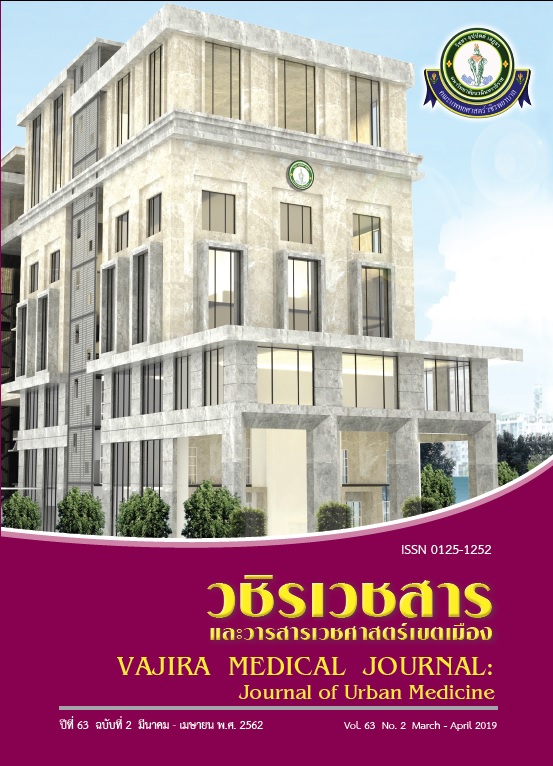Awareness of Obstetric Danger Signs and Associated Factors among Pregnant Women Attending Antenatal care at the Faculty of Medicine Vajira Hospital
Main Article Content
Abstract
Objective: To discover the prevalence of good danger signs awareness, associated factors, and predictive factors for good danger signs awareness in pregnant women attending antenatal clinic.
Methods: A cross-sectional study was conducted at Faculty of Medicine Vajira Hospital, from 1 June to 31 December 2017. A total 430 pregnant women gave written informed consent and 20 minutes interviewed by a well-trained research assistant at antenatal clinic, using a data record form which included demographic profile, parity, number of antenatal visits, gestational age and 16 pregnancy danger signs. The participants who recognized at least 75 percent of the total items of pregnancy danger signs were considered as ‘good awareness’, 50 – 74 of the total items were ‘fair awareness’ and 0 percent to 49 percent of the total items were ‘poor awareness’.
Results: This study showed the prevalence of good danger signs awareness was 59.8%. The good danger signs awareness was significantly associated with bachelor’s degree graduation or higher, gestational age 28 weeks, and antenatal visits ≥ 4. Significant predictive factors for good danger signs awareness were pregnant women who had a bachelor’s degree or higher (ORadj 2.02, 95% CI (1.08-3.37), p
0.001) and antenatal visits
4 (ORadj 1.89, 95% CI (1.27-2.82), p = 0.002).
Conclusions: The prevalence of good danger signs awareness was 59.8%. Associated factors were bachelor education or higher, more gestational age, and number of antenatal visits 4. Predictive factors for good awareness were high education and antenatal visits
4.
Downloads
Article Details
References
2. Alkema L, Chou D, Hogan D, Zhang S, Moller AB, Gemmill A, et al. Global, regional, and national levels and trends in maternal mortality between 1990 and 2015, with scenario-based projections to 2030: a systematic analysis by the UN Maternal Mortality Estimation Inter-Agency Group. Lancet. 2016; 387: 462–74.
3. Thaddeus S, Maine D: Too far to walk: maternal mortality in context. Soc Sci Med. 1994, 38(8):1091–110.
4. Teng SP, Zuo TC, Jummart FB, Keng SL. Knowledge of pregnancy danger signs and associated factors among Malaysian mothers. BJM. 2015; 23: 130-4.
5. Abiyot TI, Kassa ME, Buruh GR, Kidanu KA. Awareness of obstetric danger signs and its associated factors among pregnant women in public health institutions Mekelle city Tigray, Ethiopia. J Preg Child Health. 2015; 2:167-70.
6. Karkee R, Baral OB, Khanal V, Lee AH. The role of obstetric knowledge in utilization of delivery service in Nepal. Health Educ Res. 2014;29(69):1041–48.
7. Perreira KM, Bailey PE, de Bocaletti E, Hurtado E, Racinos de Villagran S, Matute J. Increasing awareness of danger signs in pregnancy through community- and clinic-based education in Guatemala. Matern Child Health J. 2002, 6(1): 19–28.
8. Maseresha N, Woldemichael K, Dube L. Knowledge of obstetric danger signs and associated factors among pregnant women in Erer district, Somali region, Ethiopia. BMC Womens Health. 2016; 16(30): 1 – 8.
9. Acharya TK, Poudel A. Knowledge Regarding Obstetric Danger Signs Among Antenatal Mothers Attending A Tertiary Level Hospital. IJNRP. 2016; 3(2): 31 – 40.
10. Pembe AB, Urassa DP, Carlstedt A, Lindmark G, Nyström L, Darj E. Rural Tanzanian women’s awareness of danger signs of obstetric complications. BMC Pregnancy Childbirth. 2009; 9(12): 1 – 8.
11. Rashad WA, Essa RM. Women’s awareness of danger sign of obstetrics complication. J Am Sci. 2010; 6(10): 1299-306.
12. Bogale D, Markos D. Knowledge of obstetric danger signs among child bearing age women in Goba district, Ethiopia: a cross-sectional study. BMC Pregnancy Childbirth.2015; 15(77): 1 – 8.
13. Bililign N, Mulatu T. Knowledge of obstetric danger signs and associated factors among reproductive age women in Raya Kobo district of Ethiopia: A community based cross-sectional study. BMC Pregnancy Childbirth. 2017; 17(70):1 – 7.
14. Salem A, Lacour O, Scaringella S, Herinianasolo J, Benski AC, Stancanelli G, et al. Cross-sectional survey of knowledge of obstetric danger signs among women in rural Madagascar. BMC Pregnancy Childbirth. 2018; 18(46): 1 – 9.
15. JHPIEGO. Monitoring Birth Preparedness and Complication Readiness: Tools and Indicators for Maternal and Newborn Health. Maryland, USA: JHPIEGO; 2004.
16. Sangal R, Sivastava R, Singh A, Meera, Humakarn. Knowledge and practices regarding obstetric danger signs in women attending ante-natal care clinic at BRD medical college Gorakhpur City India. Indian J Prev Soc Med. 2012; 43: 56-9.
17. Hibstu DT, Siyoum YD. Knowledge of obstetric danger signs and associated factors among pregnant women attending antenatal care at health facilities of Yirgacheffe town, Gedeo zone, Southern Ethiopia. Arch Public Health. 2017; 75(35): 1 – 9.
18. Hibstu DT, Siyoum YD. Knowledge of obstetric danger signs and associated factors among pregnant women attending antenatal care at health facilities of Yirgacheffe town, Gedeo zone, Southern Ethiopia. Arch Public Health. 2017; 75(35): 1 – 9.
19. Okour A, Alkhateeb M, Amarin Z. Awareness of danger signs and symptoms of pregnancy complication among women in Jordan. Int J Gynecol Obstet. 118 (2012) 11– 4.


